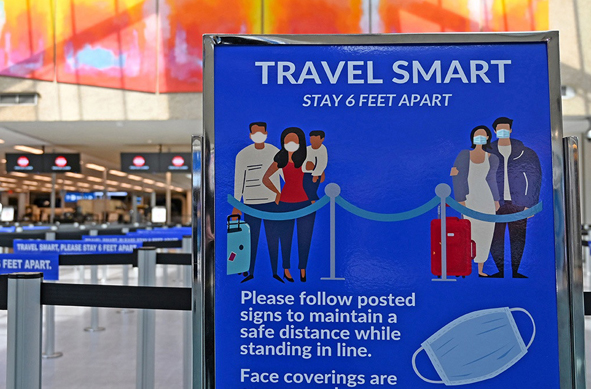Orlando airport uses lidar to maintain social distancing
- January 25, 2021
- Steve Rogerson

Californian companies Indoor Lab and Cepton have delivered lidar-based space and crowd analytics to Orlando International Airport to help it maintain social distancing and cleaning.
The lidar-based real-time crowd analytics is helping the airport create a safe terminal during the Covid-19 pandemic.
Deployed by Indoor Lab, the Safe Place real-time foot traffic system uses lidar sensors as part of Cepton’s Helius smart lidar offering.
Helius enables Indoor Lab to provide intelligent, anonymised, 3D tracking of people, thereby improving the usability, safety and cleanliness of large spaces. Indoor Lab’s visual analytics platform, leveraging Helius, powers the Synect Evenflow Crowd Radar media lights in terminal two of the airport.
The airport is one of several early projects initiated by Indoor Lab and Cepton as part of their partnership. Indoor Lab is Cepton’s early-stage development and analytics partner for lidar analytics. This partnership lays the foundation for innovations that could save time and money, enable more efficient design of public and private commercial spaces, and add the capability to improve public safety during the Covid-19 pandemic and recovery.
“We have a 15-year history of crowd tracking across retail, events, airports and stadiums,” said Patrick Blattner, chief product officer of Indoor Lab. “So, when Covid-19 started spreading exponentially and negatively affected many public and private spaces, we consulted with leaders involved in drafting proposals for the International Franchise Association, including the use of lidar technology to help put the country back on a path towards normalcy.”
With public concerns focused on cleanliness of public and commercial spaces, Indoor Lab extended its Safe Place platform beyond occupancy and social distancing, creating proprietary real-time sanitisation detection. A Safe Place enabled environment ensures locations have been cleaned, distancing measures are followed, and safer occupancy levels are maintained.
“Our partnership with Cepton helped us deliver against this promise,” said Blattner. “Our patent-pending Safe Place platform with real-time cleaning detection is the first of its kind in the world.”
The set-up implemented in Orlando led to an improvement in people’s adherence to social distancing during the busy holiday travel season. The effectiveness of the crowd analytics system relies on the high point density and detection range of Cepton’s MMT-based Vista-series lidars and Helius system that provides object dimensions, locations and velocities at high accuracy.
The mirrorless, frictionless and rotation-free MMT architecture enables lidars that are reliable and easy to integrate for both indoor and outdoor applications. In addition, Helius allows aggregation of data from multiple Cepton lidar sensors to form a comprehensive and extendable network for seamless tracking. For instance, this allows the anonymised tracking of the same person across large overlapping areas, which, according to Indoor Lab, is another game-changing factor that differentiates Helius from other lidar systems.
In the Orlando deployment, Indoor Lab used seven Vista lidar sensors from Cepton to cover seamlessly nearly 100% of the terminal area of roughly 4600 square metres, something that would otherwise have required significantly more video cameras, each consuming far more data and storage bandwidth compared with the lidars. Unlike video cameras, lidars also perform accurately round-the-clock regardless of lighting conditions.
Another advantage of lidar compared with cameras is that it does not capture biometric data. While lidar sensors provide information to help detect, track and classify objects accurately, they do not show facial features and skin or hair colour, increasing protection of people’s privacy and reducing analytical bias.
“The great thing about lidar-based crowd analytics is that it is compliant with privacy laws,” said Blattner. “At the same time, the system can also integrate with point, tilt and zoom cameras to detect potential public safety risks, such as a bag left behind in a public space or people unexpectedly moving at high speed.”
The partnership between Cepton and Indoor Lab extends beyond projects in airports. Using Cepton’s technology, Indoor Lab is monitoring real-time traffic globally across hotels, stadiums, large commercial venues and retail spaces. Indoor Lab’s software provides real-time information on crowd density, as well as dwell times, motion tracking and speed of individuals. Using these data, enterprises can optimise the experience in their spaces to manage queues, reduce crowding, optimise layout of aisles, walkways and shops, as well as address safety and security risks.
“After evaluating most of the lidar hardware and 3D perception software offerings on the market, Indoor Lab has identified Cepton to be the leader with a combination that provides the point-cloud density, accuracy, reliability and ease and cost of integration required to properly enable crowd analytics,” said Patrick Mooney, CTO at Indoor Lab. “Together with the Cepton team, we have successfully monitored and analysed dense crowds in some of the most challenging environments.”
Jun Pei, Cepton’s CEO, added: “We are grateful for the partnership with Indoor Lab and for their adoption of Cepton’s cutting-edge technology to deploy their path-breaking innovations into a range of diverse applications. The power of this partnership is already evident in the remarkable results recently showcased by Indoor Lab with their other partners. We worked closely with Indoor Lab to ensure we were able to deliver the capabilities and accuracy needed for their smart space applications at an affordable price.”
Founded in 2016, Cepton is focused on the mass-market commercialisation of lidar. The company is headquartered in San Jose, California, with a presence in Germany, Canada, Japan and India.





